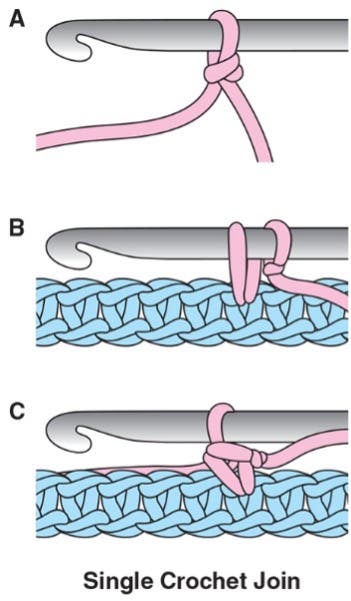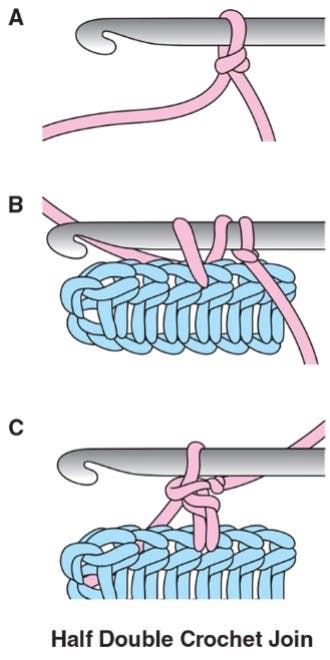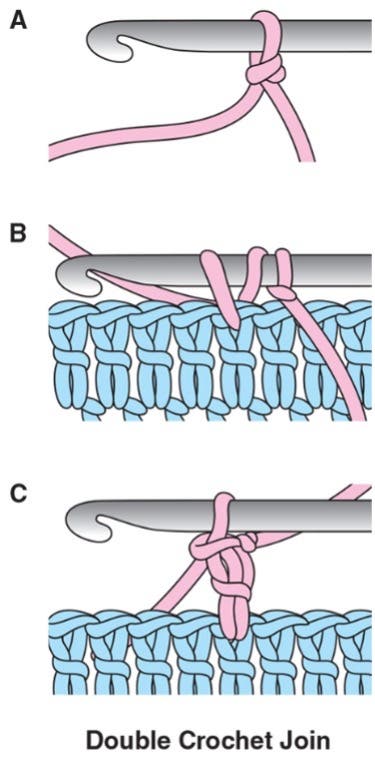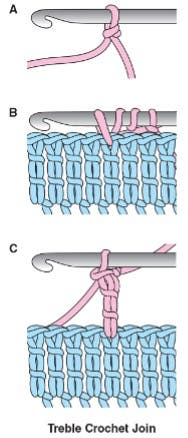Chainless Joins
In crochet you typically need to build up the height of a new row or round to work the stitches of that row or round. You use turning chains to do this. Each type of stitch has a certain number of chains that are used to reach the height of that stitch. For example, a single crochet or slip stitch row is built up by using a chain-one. A double crochet row is built up using chain-two or -three (depending on designer’s choice). These chains are a bit flimsy and not has thick as the stitches of the row. Chainless joins are a way of building up the height of a row or round that is less noticeable and more sturdy than a chain.
The information below will first go over chainless joins to be used if you are joining a new ball or color of yarn to your project. You will work a basic stitch as your starting stitch. Then it will move on to show you how to create a sturdy beginning stitch by stacking stitches on top of each other when starting a new row or round.
Note: Crochet does not have standardized naming conventions for special stitches. Designers may call stitches by whatever name they prefer. For this reason, it is difficult to search online for how a particular special stitch is created. Another reason it is hard to find the “correct” way to work a particular special stitch is because each designer might work a special stitch in their own unique way. Be sure to follow the directions stated in your pattern for how to work a stitch.
Single Crochet Join (abbreviated sc join)
Use this join to add a new color or ball of yarn when beginning a row or round; it will give your work a more invisible start.
Place a slip knot on the hook (A), insert the hook in the indicated stitch, yarn over, pull up a loop (B), yarn over and draw through both loops on the hook (C).


Half Double Crochet Join (abbreviated hdc join)
Use this join to add a new color or ball of yarn when beginning a row or round; it will give your work a more invisible start.
Place a slip knot on the hook (A), yarn over, insert the hook in the indicated stitch (B), yarn over, pull up a loop, yarn over and draw through all loops (C).


Double Crochet Join (abbreviated dc join)
Use this join to add a new color or ball of yarn when beginning a row or round; it will give your work a more invisible start.
Place a slip knot on the hook (A), yarn over, insert the hook in the indicated stitch (B), yarn over, pull up a loop, [yarn over, draw through 2 loops] twice (C).


Treble Crochet Join (abbreviated tr join)
Use this join to add a new color or ball of yarn when beginning a row or round; it will give your work a more invisible start.
Place a slip knot on the hook (A), yarn over twice, insert the hook in the indicated space and pull up a loop (B), [yarn over and draw through 2 loops] 3 times (C).


Stacked Stitches
Stacked stitches are an alternative to a turning chain where you stack stitches one on top of the other. This produces a more sturdy beginning stitch. This is a thicker stitch than a turning chain so it is also less noticeable in the fabric.
These stitches create a nice straight edge and eliminate the gap between the first and second stitch that a normal turning chain has. There is more than one way to work a stacked stitch. A couple of options for each basic stitch are given below.
Stacked Half Double Crochet (abbreviated stacked hdc or hdc beg st)
This stitch is used to create a solid stitch at the beginning of the row or round for motifs and other projects that benefit from a firm edge.
Version 1 (shown in video): Insert the hook in the first stitch, yarn over, pull up a loop, yarn over, pull through both loops (single crochet has been made). Insert hook from right to left in the left leg of the stitch just made, yarn over, pull up a loop, yarn over, pull through both loops (2nd single crochet had been made).
Version 2: Insert the hook in the first stitch, yarn over, pull up a loop, yarn over, pull through both loops (single crochet has been made). Chain 1.
This completes the stacked half double crochet and produces a stitch with two chains along the right side edge, just like if you would have chained two to start. But unlike a chain-two, this stitch is thick, sturdy and has a nice straight side edge. Complete the row as directed in your pattern.
If last stitch of the row is a stacked half double crochet, to work the last stitch of the row, go into the top two loops of the stitch and complete your final stitch.
Stacked Double Crochet (abbreviated stacked dc or dc beg st)
This stitch is used to create a solid stitch at the beginning of the row or round for motifs and other projects that benefit from a firm edge.
Version 1 (shown in video): Insert the hook in the first stitch, yarn over, pull up a lp, yarn over, pull through both loops (single crochet has been made). [Insert the hook from right to left in the left leg of the stitch just made, yarn over, pull up a loop, yarn over, pull through both loops (single crochet has been made)] twice.
Version 2: Insert the hook in the first stitch, yarn over, pull up a loop, yarn over, pull through both loops (single crochet has been made). Insert the hook from right to left in the left leg of the stitch just made, yarn over, pull up a loop, yarn over, pull through both loops (single crochet has been made). Chain 1.
This completes the stacked double crochet and produces a stitch with three chains along the right side edge, just like if you would have chained three to start. But unlike a chain-three, this stitch is thick, sturdy and has a nice straight side edge. Complete the row as directed in your pattern.
If last stitch of the row is a stacked double crochet, to work the last stitch of the row, go into the top two loops of the stitch and complete your final stitch.
Stacked Treble Crochet (abbreviated stacked tr or tr beg st)
This stitch is used to create a solid stitch at the beginning of the row or round for motifs and other projects that benefit from a firm edge.
Version 1 (shown in video): Insert the hook in the first stitch, yarn over, pull up a loop, yarn over, pull through both loops (single crochet has been made). [Insert the hook from right to left in the left leg of the stitch just made, yarn over, pull up a loop, yarn over, pull through both loops (single crochet has been made)] 3 times.
Version 2: Insert the hook in the first stitch, yarn over, pull up a loop, yarn over, pull through both loops (single crochet has been made). [Insert the hook from right to left in the left leg of the stitch just made, yarn over, pull up a loop, yarn over, pull through both loops (single crochet has been made)] twice. Chain 1.
This completes the stacked treble crochet and produces a stitch with four chains along the right side edge, just like if you would have chained four to start. But unlike a chain-four, this stitch is thick, sturdy and has a nice straight side edge. Complete the row as directed in your pattern.
If last stitch of the row is a stacked treble crochet, to work the last stitch of the row, go into the top two loops of the stitch and complete your final stitch.
